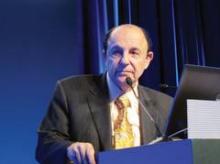BARCELONA – Starting a triple-drug regimen of metformin, exenatide, and pioglitazone at the onset of type 2 diabetes decreased 2-year treatment failure rates by 84%, compared with a conventional, stepwise treatment program.
After 2 years, patients taking the combination treatment showed significantly lower hemoglobin A1c levels than those who had graduated treatment – a mean of 5.9% vs. 6.6%, Dr. Ralph A. DeFronzo said at the annual meeting of the European Association for the Study of Diabetes.
If those interim results hold for the length of the 3-year study, they have the potential to dramatically alter the long-term consequences of poorly controlled type 2 diabetes, said Dr. DeFronzo, deputy director of the Texas Diabetes Institute, San Antonio.
"If we could maintain an HbA1c of 5.9% after 3 years, I don’t think we will see many patients going on to develop blindness or kidney failure," he noted. "We may pay more up front for these more-expensive drugs, but we need to think of what will happen in 10 years if we really can control the HbA1c and prevent microvascular complications."
The open-label study – partially funded by the American Diabetes Association – compared the two treatment strategies among patients with newly diagnosed type 2 diabetes.
Conventional therapy consisted of stepwise treatment beginning with 1 g metformin daily. Over the first 3 months, that could be augmented by increasing metformin to 2 g/day and, if necessary, adding up to 20 mg/day of glipizide. If HbA1c still didn’t meet the 6.5% target, up to 60 units of insulin glargine could be added on as needed. Patients were removed from the study and censored if their blood sugar remained elevated despite being on all three drugs, including the maximum insulin dose.
The triple-drug therapy used three drugs from the very beginning: metformin 1 g/day; pioglitazone 30 mg/day; and exenatide 10 mcg/day.
The drugs were chosen to combat diabetes on three pathophysiologic fronts, Dr. DeFronzo said. "Metformin is a good insulin sensitizer in the liver, but has no effect on muscle and does nothing for beta cells. Pioglitazone is a powerful insulin sensitizer that works in both muscle and liver. And exenatide exerts beneficial effects on both alpha- and beta-cells, and promotes weight loss."
The regimen’s aim is to stem the decline of beta-cell function, which Dr. DeFronzo said is virtually inevitable in most type 2 patients.
"As long as the beta-cells are healthy, people destined to develop type 2 diabetes can secrete enough insulin to overcome their [genetic predilection for] insulin resistance," he explained. "But their beta-cells are preprogrammed to die, and as they fail, we see the onset of impaired glucose tolerance and eventually, the development of overt diabetes.
"Our hypothesis was that we could initiate early therapy with agents that can correct these known pathophysiologic abnormalities and achieve a greater, more durable reduction in HbA1c, while avoiding hypoglycemia."
The open-label study randomized 169 patients with newly diagnosed type 2 diabetes who were also drug-naive to either the conventional therapy (90 patients) or triple therapy (79 patients). The patients had mean disease duration of 5 months, and all had been diagnosed less than 2 years earlier. All medications could be adjusted as necessary to avoid hypoglycemia.
All patients were seen every 12 weeks, at which time they had measures of fasting plasma glucose, postprandial glucose, HbA1c, and weight. Their daily home blood glucose monitoring data were also reviewed. The primary endpoint was treatment failure, defined as an HbA1c of more than 6.5% on two consecutive visits 3 months apart, despite being on maximum therapy. Secondary endpoints were changes in fasting and postprandial glucose, rates of hypoglycemia, and other adverse events.
The cohort’s mean age was 47 years, and their mean body mass index was 36 kg/m2. They had a mean HbA1c of 8.6%, but the range was wide, from 6.6% to 14%. It was more than 10% in about a quarter of the group. The mean fasting plasma glucose was 190 mg/dL.
In the first 6 months of treatment, HbA1c in both groups fell rapidly and significantly, to a mean of 6.6%, Dr. DeFronzo said. After that, patients in the conventional therapy group began to experience a slow increase in their blood sugar levels – a phenomenon consistently observed in studies and in clinical practice. By the end of 24 months, the mean HbA1c in the group was 6.6%.
Those in the triple-therapy group, however, experienced a continued, slow decline in blood sugar levels. By 24 months, the mean HbA1c in the triple-therapy group was 5.9% – significantly lower than that in the conventional group. Significantly more of the triple-therapy group achieved a median HbA1c of less than 6% (60% vs. 27%), and of less than 7% (92% vs. 72%).

